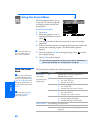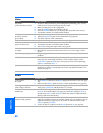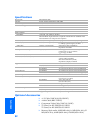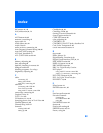
76
Other Info SETUP WelcomeSETUP SETUPSETUP
Glossary
analog signal A signaling method that uses continuous changes in the amplitude or frequency of an
electronic transmission to convey information.
aspect ratio Refers to the ratio between the width and height of the screen. This TV has a 4:3 aspect ratio,
as opposed to a 16:9 (widescreen) aspect ratio.
component video Component video is sent through three cables: two color shade (chrominance) signals and one
brightness (luminance) signal. Component video achieves greater color accuracy than
composite video or S VIDEO by splitting chrominance into two separate portions.
composite video Composite video is sent through a single cable. Composite video combines the color shade
(chrominance) and brightness (luminance) information into one video signal.
degauss A process that demagnetizes the metal components in the TV monitor, which eliminates image
distortion that can result from magnetic charges acquired by the TV’s components. Your TV
degausses automatically when it is turned on.
digital television (DTV) A new technology for transmitting and receiving broadcast television signals. DTV provides
clearer resolution and improved sound quality over analog television.
National Television System
Committee (NTSC)
A unit of the Federal Communications Commission, Washington, DC, that establishes
television standards in the United States, such as NTSC Color, the standard used in this TV.
RF Radio Frequency. That part of the frequency spectrum in which it is possible to radiate
(transmit) electromagnetic waves.
S VIDEO S VIDEO requires a single cable, which carries the brightness (luminance) and color
(chrominance) signals of the picture separately. S VIDEO provides better resolution than
composite video, which carries the signals together.
VHF/UHF VHF (Very High Frequency) is the part of the radio spectrum from 30 to 300 megahertz. UHF
(Ultra High Frequency) is the part of the radio spectrum from 300 to 3,000 megahertz.
480i Provides 480 lines of resolution. Displays images using interlaced scanning, which first
transmits all the odd lines on the TV screen and then the even lines.
480p Provides 480 lines of resolution. Displays images using progressive scanning, which transmits
each line from top to bottom.
720p Provides 720 lines of resolution. Displays images using progressive scanning, which transmits
each line from top to bottom.
1080i Provides 1080 lines of resolution. Displays images using interlaced scanning, which first
transmits all the odd lines on the TV screen and then the even lines. 1080i is one of the
formats used by HDTV (High Definition TV).
16:9 aspect ratio
4:3 aspect ratio


















